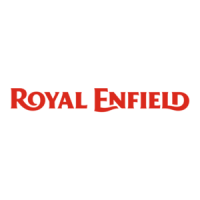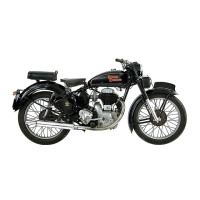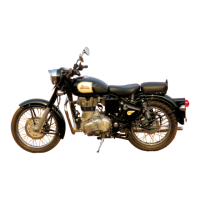
Do you have a question about the Royal Enfield 350 BULLET 1950 and is the answer not in the manual?
| Brand | Royal Enfield |
|---|---|
| Model | 350 BULLET 1950 |
| Category | Motorcycle |
| Language | English |
Valve timing specifications at 0.012 inch clearance.
Valve timing specifications at 0.012 inch clearance.
General description of the engine's configuration and features.
Details of the dry-sump lubrication system.
Carburetter types for 350cc and 500cc engines.
Description of the gearbox, speeds, and ratios.
Details on the clutch mechanism for 350 and 500 Bullet models.
Procedure for removing and refitting the timing cover.
Instructions for setting the valve timing correctly.
Steps for adjusting the tappet clearances.
Procedure for setting the ignition timing.
Process for decarbonising the engine components.
Procedure for overhauling the oil pumps.
Procedure for removing the Magdyno unit.
Procedure for removing the cylinder head.
Steps for reassembling engine components after decarbonising.
Procedure for removing the cylinder barrel.
How to adjust the primary chain tension.
Procedure for removing the clutch assembly.
Steps to remove the piston from the cylinder.
Steps to remove the engine from the motorcycle frame.
Procedure for removing the gearbox.
Steps to dismantle the crankcase halves.
Instructions for reassembling the crankcase halves.
Instructions for gearbox removal.
Steps to dismantle the gearbox assembly.
Steps for reassembling the gearbox.
Procedure for clutch disassembly and reassembly.
Description of carburetters with pilot jet systems.
Table of specifications for Amal needle type carburetters.
Explanation of carburetter operation and identification of parts.
Instructions for tuning twin carburetters.
Troubleshooting guide for carburetter faults.
Steps for tuning the carburetter.
General description of the Amal Monobloc carburetter.
Instructions for tuning the Amal Monobloc carburetter.
Steps to dismantle the Amal Monobloc carburetter.
Reasons for high petrol consumption and solutions.
Procedure for testing the Magdyno on the engine.
Troubleshooting faults in the charging circuit.
Procedure to dismantle the dynamo.
Dynamo reassembly procedure.
Checking wiring connections between battery and regulator.
Checking the regulator's electrical settings.
Adjusting the electrical setting of the regulator.
Checking the electrical setting of the cut-out.
Adjusting the electrical setting of the cut-out.
General description of the PUZ7E battery.
Steps for preparing the battery for service.
Exploded view of the frame for 1954-1955 models.
General description of the frame construction.
Steps to remove the rear suspension unit.
Instructions for checking and adjusting wheel alignment.
Description of front fork with casquette and alloy bottom tubes.
Explanation of how the front fork operates.
Steps to remove the complete front fork assembly.
Description of front fork with facia panel and alloy bottom tubes.
Explanation of the front fork operation.
Procedure to dismantle the fork for part replacement.
Steps to remove the fork main tubes.
Steps to remove fork head, spring, and related parts.
Description of front fork with facia panel and steel bottom tubes.
Procedure to dismantle fork for part replacement.
Steps to remove fork head, spring, and related parts.
Steps to remove the fork main tubes.
Procedure to remove brake cover plate assemblies.
Steps to remove the front wheel from the fork.
Steps to remove brake shoes and springs.
General description of the non-detachable rear wheel.
Steps to remove hub spindle and bearings.










